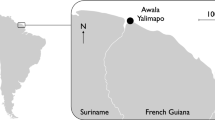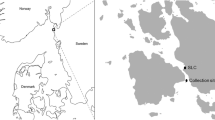Abstract
Microbial grazing by two species of meiofaunal harpacticoid copepods (Heteropsyllus nunni and Thompsonula hyaenae) was determined by uptake of radioactive labels following their introduction into natural sediments from a low-energy intertidal site in Florida (29°54′40″N; 84°31′30″W) in May 1986. Grazing was related to three methods of radioactive-label introduction: injection, porewater replacement, and slurry. Uptake of label by harpacticoids was examined using two dual-label combinations, 3H-thymidine/14C-bicarbonate and 3H-thymidine/14C-acetate. The injection and porewater-replacement methods yielded statistically indistinguishable results. Results obtained by the slurry method differed significantly from the other two methods. We suggest that the unique results obtained in the slurry method were a consequence of the disruption of microbial-meiofaunal spatial relationships.
Similar content being viewed by others
Literature cited
Alongi, D. M. (1988). Microbial-meiofaunal interrelationships in some tropical intertidal sediments. J. mar. Res. 45: 349–365
Carman, K. R., Thistle, D. (1985). Microbial food partitioning by three species of benthic copepods. Mar. Biol. 88: 143–148
Conover, R. J., Francis, V. (1973). The use of radioactive isotopes to measure the transfer of materials in aquatic food chains. Mar. Biol. 18: 272–283
Decho, A. W., Castenholz, R. W. (1986). Spatial patterns and feeding of meiobenthic harpacticoid copepods to resident microbial flora. Hydrobiologia 131: 87–96
Decho, A. W., Fleeger, J. W. (1988). Ontogenetic feeding shifts in the meiobenthic harpacticoid copepod Nitocra lacustris. Mar. Biol. 97: 191–197
Dobbs, F. C., Guckert, J. B., Carman, K. R. (1989). Comparison of three techniques for administering radiolabeled substrates to sediments for trophic studies: incorporation by microbes. Microb. Ecol. (in press)
Findlay, S. E. G. (1981). Small-scale spatial distribution of meiofauna on a mud- and sandflat. Estuar., cstl Shelf Sci. 12: 471–484
Fleeger, J. W., Decho, A. W. (1987). Spatial variability of interstitial meiofauna: a review. Stygologia 3: 35–54
Fleeger, J. W., Gee, J. M. (1986). Does interference competition determine the vertical distribution of meiobenthic copepods? J. exp. mar. Biol. Ecol. 95: 173–181
Grant, I. F., Egan, E. A., Alexander, M. (1983). Measurement of rates of grazing of the ostracod Cyprinotus carolinensis on bluegreen algae. Hydrobiologia 106: 199–208
Hicks, G. R. F., Coull, B. C. (1983). The ecology of marine meiobenthic harpacticoid copepods. Oceanogr. mar. Biol. A. Rev. 21: 67–175
Hollander, M., Wolfe, D. A. (1973). Nonparametric statistical methods. John Wiley & Sons, New York
Hollibaugh, J. T., Fuhrman, J. A., Azam, F. (1980). Radioactive labeling of natural assemblages of bacterioplankton for use in trophic studies. Limnol. Oceanogr. 25: 172–181
Joint, I. R., Gee, J. M., Warwick, R. M. (1982). Determination of fine-scale vertical distribution of microbes and meiofauna in an intertidal sediment. Mar. Biol. 72: 157–164
Lee, J. J., Tietjen, J. H., Mastropaolo, C., Rubin, H. (1977). Food quality and the heterogenous spatial distribution of meiofauna. Helgoländer wiss. Meeresunters. 30: 272–282
Meyer-Reil, L.-A. (1987). Seasonal and spatial distribution of extracellular enzymatic activities and microbial incorporation of dissolved organic substrates in marine sediments. Appl. envirl Microbiol. 53: 1748–1755
Meyer-Reil, L.-A., Faubel, A. (1980). Uptake of organic matter by meiofauna organisms and interrelationships with bacteria. Mar. Ecol. Prog. Ser. 3: 251–256
Montagna, P. A. (1983). Live controls for radioisotope tracer food chain experiments using meiofauna. Mar. Ecol. Prog. Ser. 12: 43–46
Montagna, P. A. (1984a). In situ measurement of meiobenthic grazing rates on sediment bacteria and edaphic diatoms. Mar. Ecol. Prog. Ser. 18: 119–130
Montagna, P. A. (1984b). Competition for dissolved glucose between meiobenthos and sediment microbes. J. exp. mar. Biol. Ecol. 76: 177–190
Montagna, P. A., Bauer, J. E. (1988). Partitioning radiolabeled thymidine uptake by bacteria and meiofauna using metabolic blocks and poisons in benthic feeding studies. Mar. Biol. 98: 101–110
Montagna, P. A., Coull, B. C., Herring, T. L., Dudley, B. W. (1983). The relationship between abundances of meiofauna and their suspected microbial food (diatoms and bacteria). Estuar., cstl Shelf Sci. 17: 381–394
Moriarty, D. J. W. (1986). Measurement of bacterial growth rates in aquatic systems from rates of nucleic acid synthesis. Adv. microb. Ecol. 9: 245–280
Moriarty, D. J. W., Pollard, P. C. (1981). DNA synthesis as a measure of bacterial productivity in seagrass sediments. Mar. Ecol. Prog. Ser. 5: 151–156
Munro, A. L. S., Brock, T. D. (1968). Distinction between bacterial and algal utilization of soluble substances in the sea. J. gen. Microbiol. 51: 35–42
Novitsky, J. A. (1983). Microbial activity at the sediment-water interface in Halifax Harbor, Canada. Appl. envirl Microbiol. 45: 1761–1766
Roman, M. R., Rublee, P. A. (1981). A method to determine in situ zooplankton grazing rates on natural particle assemblages. Mar. Biol. 65: 303–309
Thistle, D., Reidenauer, J. A., Findlay, R. H., Waldo, R. (1984). An experimental investigation of enhanced harpacticoid (Copepoda) abundances around isolated seagrass shoots. Oecologia 63: 295–299
Author information
Authors and Affiliations
Additional information
Communicated by J. M. Lawrence, Tampa
Rights and permissions
About this article
Cite this article
Carman, K.R., Dobbs, F.C. & Guckert, J.B. Comparison of three techniques for administering radiolabeled substrates to sediments for trophic studies: uptake of label by harpacticoid copepods. Marine Biology 102, 119–125 (1989). https://doi.org/10.1007/BF00391329
Accepted:
Issue Date:
DOI: https://doi.org/10.1007/BF00391329




